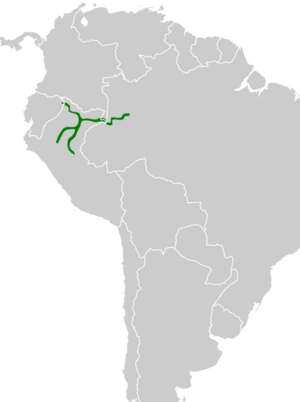Bay hornero facts for kids
Quick facts for kids Bay hornero |
|
|---|---|
 |
|
| Illustration by Joseph Smit, 1890 | |
| Conservation status | |
| Scientific classification | |
| Genus: |
Furnarius
|
| Species: |
torridus
|
 |
|
The bay hornero or pale-billed hornero (Furnarius torridus) is a cool bird from the ovenbird family. It lives in parts of South America, like Brazil, Colombia, and Peru. It might even live in Ecuador too!
Contents
About the Bay Hornero's Family Tree
For a while, scientists weren't sure if the bay hornero was its own special bird. Some thought it was just a type of another bird called the pale-legged hornero. But now, thanks to new information, everyone agrees it's a unique species. It's the only bird of its kind, meaning it doesn't have any subspecies.
What Does the Bay Hornero Look Like?
The bay hornero is a sturdy bird, about 16 to 19 cm (6.3 to 7.5 in) long. That's about the length of a small ruler! It weighs around 53 g (1.9 oz), which is like a small apple. Both male and female bay horneros look alike.
They have a dull, light cream stripe above their eyes, called a supercilium. Their head and neck are grayish-brown. Their back, rump, and tail are a rich chestnut brown, which is often called "bay." Most of their wings are also chestnut brown.
Their throat is white, with dark brownish sides. Their chest is dark brownish, while their sides are light brown. Their belly is whitish, and the feathers under their tail are dark with chestnut brown tips. Their eyes are brown or reddish-brown. Their beak is light brown on top and whitish or pinkish-gray underneath. Their legs and feet are cream or very light pink.
Where Does the Bay Hornero Live?
The bay hornero lives in the western Amazon Basin. You can find it along rivers like the Huallaga, Ucayali, and Napo in Peru. It also lives in southern Colombia and western Brazil, along the upper Amazon River. Some people have seen it in Ecuador, but scientists are still checking if it truly lives there.
This bird mostly lives on river islands that get flooded every year. It likes areas with Cecropia trees. It can also be found on older islands and in várzea forests along the rivers. In Colombia, it's often seen on grassy islands.
How Does the Bay Hornero Live?
Movement
The bay hornero stays in the same area all year round. It doesn't migrate to other places.
Feeding
We don't know a lot about what the bay hornero eats or how it finds its food. It usually looks for food on the ground, often in pairs. They like to search under plants that hang over. Scientists think they eat arthropods, like insects, and other small creatures that live on the ground.
Breeding
The bay hornero builds a special nest, just like other birds in its family. It's a mud dome with an entrance on the side. They usually build these nests on horizontal tree branches. Besides this, not much else is known about how they raise their young.
Vocalization
The bay hornero's song is a long, fast series of notes that go down in pitch. It sounds a bit like the pale-legged hornero's song, but it has a unique ending with notes that go up quickly. Some describe it as a "hurried series of loud, fluted notes, ending in a tremolo." Its calls include a sharp keek or tseek sound.
Is the Bay Hornero in Danger?
The IUCN (International Union for Conservation of Nature) says the bay hornero is a species of "Least Concern." This means it's not currently in danger of disappearing. It lives across a fairly large area, but its population size is unknown and might be getting smaller. There are no immediate threats that scientists have found. In Peru, it's considered "uncommon to fairly common."


